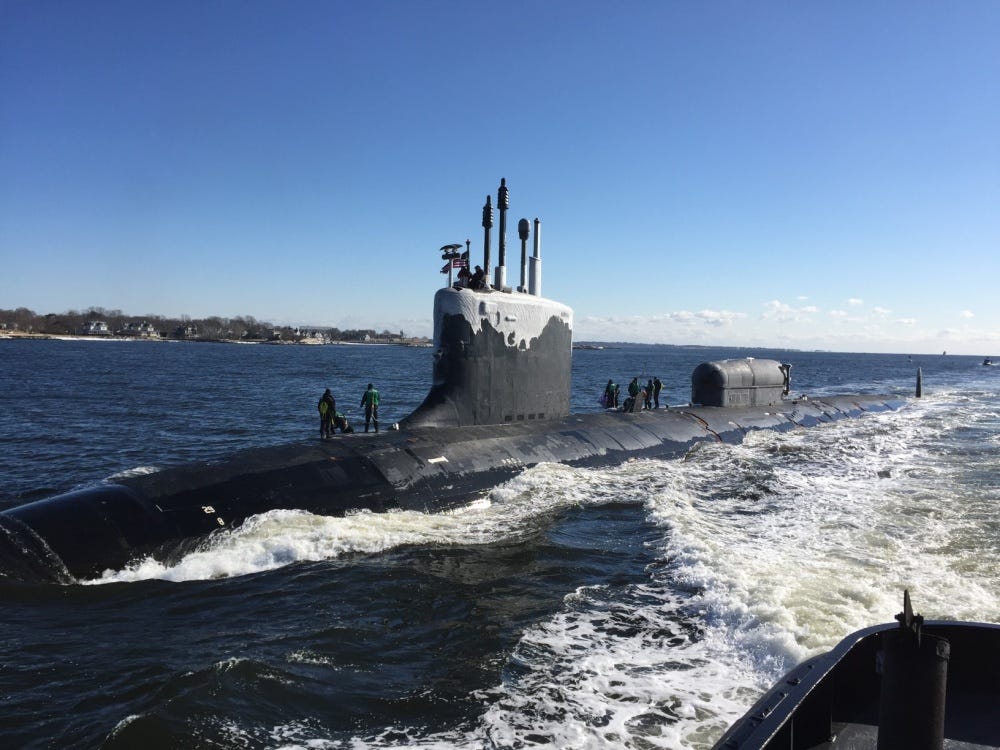
US Air Force photo by Staff Sgt. Gerald R. Willis
- US Navy techs are having to cannibalize parts of F/A-18 Super Hornets and Virginia-class submarines.
- A new GAO report documents data rights issues that cause repair issues and delays.
- The other programs included in the report are the F-35, LCS, and Stryker.
US Navy technicians are stripping spare parts from attack submarines and F/A-18 Super Hornet carrier jets to keep other ones operational due to delays and low inventory, a new watchdog report found.
The two programs are part of five in the Defense Department reviewed by the US Government Accountability Office, a watchdog agency, that all largely face maintenance delays, a lack of spare parts, and increased costs due to a number of factors, including relying on sole source contracts.
Of the five programs, F/A-18s and Virginia-class submarines both have parts that are difficult to obtain in time for repairs, meaning sailors have to take those parts from other assets. Often, that’s because there’s a long delay in acquiring a new part from a manufacturer, and the government lacks the design information to rapidly get it from another company or fabricate it in one of its workshops.
For Super Hornets, maintainers who spoke with the GAO said they’ve been unsuccessful in getting data rights for radio frequency cables from a vendor for over a decade, and repairs for the cables are generally done on the vendor’s schedule. The data rights for making or repairing the cable are the intellectual property of the vendor.
To get more cables, Navy officials have considered reverse engineering the part to see if they could manufacture it or contract spares, but both options were too costly, the report said. “Maintainers, therefore, have resorted to cannibalizing grounded aircraft for the part,” the GAO said.
The situation is similar for Virginia-class submarines, which rely on a vendor who owns the technical data rights for certain components. “The OEM [original equipment manufacturer]’s schedule dictates the maintenance timeline, which can result in repair delays and affect operational readiness,” per the report. “Program officials also told us if OEMs do not deliver spare parts in a timely manner, maintainers must cannibalize parts from another submarine until replacements arrive.”

Photo courtesy of the US Navy
Keeping aircraft flying and submarines sailing within safety limits requires a vast supply of parts from a stretched US manufacturing base. Cannibalizing submarines and aircraft for parts is a temporary solution that increases the costs and workload of maintenance and can lead to availability issues. Removing critical parts from an aircraft or a submarine renders it out of commission until they’re replaced.
The Navy didn’t immediately respond to Business Insider’s request for comment on cannibalization issues with F/A-18s and Virginia-class submarines.
The other three programs the GAO looked at — the F-35 Lightning II stealth fighter, Littoral Combat Ship, and Stryker armored vehicle — all struggle with maintainers relying on commercial vendors for the data or rights for maintenance. The timelines for work are in the vendor’s hands and have resulted in delays.
In the case of the F-35, maintainers and program officials told the GAO the aircraft faces significant corrosion issues, which can’t be repaired without contractor support due to a lack of technical data. “In addition, according to maintainers, there are not enough contractors to respond to corrosion issues, which draws out repair timeframes,” the report said. The program is looking to fix this by gradually getting the data to have sustainment capabilities itself.
The GAO also reported an instance of a broken hydraulic motor in a crane on the littoral combat ship in which the ship repair contractor refused to fix the motor without the OEM, which had the data rights for parts and repairs. “Maintainers had to wait two and a half weeks for the OEM to be available to carry out the repair,” the GAO said. “According to shipyard officials, this was a quick turnaround and not all repairs happen that fast.”

US Air Force photo/Master Sgt. Ben Mota
And for the Stryker, program officials have been unsuccessful at acquiring unlimited data rights for the base vehicle, resulting in a 2024 technical support contract between the US Army and a prime contractor that costs about $534 million over five years.
These five programs were selected by the GAO because the agency has previously found them to have data rights issues, and the problems plaguing them point to a need for a weapons program to obtain certain technical data and data rights in order to keep them working.
“Obtaining more data or data rights than necessary can result in higher program costs or contractors refusing to bid on such contracts due to IP concerns,” the GAO said. But without the necessary data, maintainers struggle with long-term issues to keep weapons and systems going.
There are also disputes and different interpretations between officials and companies on what data the Pentagon needs for its weapons and programs, which can lead to problems within the services to maintain and repair those systems.
Read the original article on Business Insider
The post US Navy techs are stripping parts from fighter jets and subs to keep other ones working appeared first on Business Insider.




